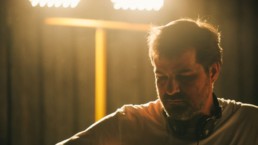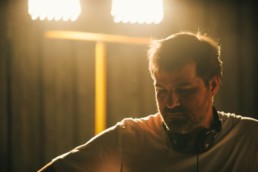Director Kornél Mundruczó on ‘White God’
"Dogs like to cooperate with humans, they'd die for us, and on set they gave a lot of energy; by the end I knew all of them name by name, all 200 of them." –Kornél Mundruczó
When White God premiered at the 2014 Cannes Film Festival, it was to the amazement of everyone in the audience how a film that looked to be a simple cross between Homeward Bound and Oliver & Company was actually a cautionary tale about self-imposed human “superiority” over lesser animals, and a pressing metaphor for the political tensions in contemporary Europe. It was evident after that first screening that director Kornél Mundruczó was a visionary, a very risky and bold artist. His execution of White God included a teenage protagonist who had never acted before, a canine cast of over 200 dogs, and a script that blended genres– not an easy feat for any director. In our exclusive interview, Mundruczó is still blown away by the amount of attention his “small Hungarian movie” is getting. I’m also happy to report that all of the dogs used in the film (which were taken from various shelters), were all adopted after filming! A happy ending all around. We begin:
When you first started writing White God and you envisioned the release day, what did you have in mind?
I’m so happy to have this movie in the USA, of course, it’s still a small Hungarian movie. When we started to do this movie, we didn’t know if it would be too radical; I didn’t know [how to describe] this movie because there were not many examples of films that used dogs in the way I wanted to use them, and the melting of genres. Once we got in the editing room I realized this movie would work, haha.
The blending of genres is definitely unique; are there any screenwriters or directors you admired going into this movie?
Hmm, that’s difficult because there are a lot, but most of them are just from my memory and childhood. I grew up in the countryside, not far from Budapest. You could watch movies in the city at two places– one of the places was The Cultural Hall where you could watch the classics. There was also the City Cinema where you could watch all of the American movies. I watched Fargo, Blade Runner, Terminator and all the Post-Apocalyptic movies a lot. So both styles were quite important to me, all of it coming from my memory. I tried to find answers in the contemporary reality I am living.
You’ve made films before, but your cast was relatively unknown. Tell me about the casting process. How did you find “Lili”?
It was really long actually. We saw lots of girls for the role, but at one point I recognized that I needed someone who doesn’t want to be an actress. At that age, I just wanted someone with personality. Soon after, I started casting at normal high schools and I would ask them if they could imagine themselves in a movie. This one girl came [to audition] and the girl behind her was Zsófia Psotta. What she did was amazing, the scene that got me was the scene where she is sleeping and then wakes up and leaves the room while her father is sleeping in the room, and she wants to escape. That was a silent scene and she was absolutely amazing. I told her immediately that I would like to shoot this movie with her but the problem was that she wasn’t totally sure she wanted to be in the movie because she didn’t want to miss class and change her life. I tried to convince her; I went to her mother with flowers and cakes and said [I need your daughter for my film]. Finally, she decided to be a part of it and from then on it went very smooth and easy. I’ve never had this kind of an adventure with an actress.
The scenes with the dogs are mesmerizing. Was there any use of CGI?
There was no CGI. That was my main conception, that would have made my life very difficult. At the beginning, everybody thought it was impossible but then I met trainer Teresa Miller from Los Angeles and she found “Luke” and “Body” who play Hagen, as well as the other 200 plus dogs from shelters. She highly socialized them together without any domination or fights. I didn’t want to illustrate how humans thought animals should react in the scenes, I wanted to shoot the dog’s real emotions. At a certain point, the dogs started to give an amazing amount of energy and emotion for the movie. Much more than I had expected before, and then I recognized that their patience, concentration, and curiosity is what made this movie.
I’m actually getting a puppy tomorrow and this film gave me a whole new perspective on dogs.
Haha right!
I know the dogs are trained, but I’m sure there was a lot of unpredictability on set.
We actually used a very special method during shooting. On one hand, we really wanted to use the perspective of the dog so we went really low with the camera and we built different types of rollers to get that perspective. And then in an empty lot in the countryside, we held lots of rehearsals with Hagen and the pack. The dogs [socialized] with us as we simulated camera moves, microphones, all sorts of things so they wouldn’t be afraid while we were shooting. Dogs like to cooperate with humans, they’d die for us, and on set they gave a lot of energy; by the end I knew all of them name by name, all 200 of them. The shooting day wasn’t very difficult because of all the rehearsal time we had. We rehearsed for three months and then we shot for almost half a year– our schedule was a week of rehearsal, a week of shooting, a week of rehearsal, a week of shooting, etc. It’s so obvious that the dogs are absolutely writing the script as well.
What was the most difficult scene for you to orchestrate?
The huge action scenes with the cars and humans in city, and then the crowd of dogs come running out together. We had really limited time to block the city streets, like a few hours. Everything was previously rehearsed but still, the logistics of shooting that scene were challenging. Other scenes were also difficult, like just walking with the dog, that was always difficult. There are so many interests and distractions on the street, dogs are always so curious. So just to create a normal walk when no humans were in the scene, like when Hagen is walking across the bridge. In the editing room, the dog fight scene was a really difficult process because the dogs were really happy to meet each other and wouldn’t stop playing. So while editing, we had to find the smallest few seconds of their “play” that looked like “fighting” to make it believable.
Your attendance at Sundance was talked about, specifically Hagen’s appearance and his little red carpet bow tie! Was was that experience like?
For a European film, Sundance is a real international festival; in my eyes, it is the most important festival to premiere a movie. I was so glad they chose my movie, it is a very open minded festival. For this small Hungarian movie, we took a lot of risks working with children and animals, melting genres, and so it wasn’t necessary a “comfortable” film. In Cannes, we started to feel the audience reacting very well and that gave us a lot of hope. This was my first time at Sundance and we had such a great audience.
I’m really looking forward to your next project, what can we expect from you in the future?
I’m working on two projects now, one is an adaptation of an amazing book called “Ice” by Vladimir Sorokin and my original script about a refugee.
Morgan Rojas
Certified fresh. For disclosure purposes, Morgan currently runs PR at PRETTYBIRD and Ventureland.





